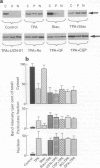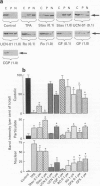Abstract
Inhibitors of protein kinase C (PKC) such as the staurosporine analogues UCN-01 and CGP 41251 possess antineoplastic properties, but the mechanism of their cytostatic action is not understood. We tested the hypothesis that the ability of these compounds to arrest growth is intrinsically linked with their propensity to inhibit PKC. Compounds with varying degrees of potency and specificity for PKC were investigated in A549 and MCF-7 carcinoma cells. When the log values of drug concentration which arrested cell growth by 50% (IC50) were plotted against the logs of the IC50 values for inhibition of cytosolic PKC activity, two groups of compound could be distinguished. The group which comprised the more potent inhibitors of enzyme activity (calphostin C, staurosporine and its analogues UCN-01, RO 31-8220, CGP 41251) were the stronger growth inhibitors, whereas the weaker enzyme inhibitors (trimethylsphingosine, miltefosine, NPC-15437, H-7, H-7I) affected proliferation less potently. GF 109203X was exceptional in that it inhibited PKC with an IC50 in the 10(-8) M range, yet was only weakly cytostatic. To substantiate the role of PKC in the growth inhibition caused by these agents, cells were depleted of PKC by incubation with bryostatin 1 (1 microM). The susceptibility of these enzyme-depleted cells towards growth arrest induced by staurosporine, RO 31-8220, UCN-01 or H-7 was studied. The drug concentrations which inhibited incorporation of [3H]thymidine into PKC-depleted A549 cells by 50% were slightly, but not significantly, lower than significantly, lower than those observed in control cells. These results suggest that PKC is unlikely to play a direct role in the arrest of the growth of A549 and MCF-7 cells mediated by these agents. Staurosporine is not only a strong inhibitor of PKC but also mimics activators of this enzyme in that it elicits the cellular redistribution of certain PKC isoenzymes. The ability of kinase inhibitors other than staurosporine to exert a similar effect was investigated. Calphostin C, H-7, H-7I, miltefosine, staurosporine, UCN-01, RO 31-8220, CGP 41251 or GF 109203X were incubated for 30 min with A549 cells in the absence or presence of the PKC activator 12-O-tetradecanoyl phorbol-13-acetate. The subcellular distribution of PKC-alpha-, -epsilon and -zeta was measured by Western blot analysis. None of the agents affected PKC-alpha or -zeta.(ABSTRACT TRUNCATED AT 400 WORDS)
Full text
PDF







Images in this article
Selected References
These references are in PubMed. This may not be the complete list of references from this article.
- Akinaga S., Gomi K., Morimoto M., Tamaoki T., Okabe M. Antitumor activity of UCN-01, a selective inhibitor of protein kinase C, in murine and human tumor models. Cancer Res. 1991 Sep 15;51(18):4888–4892. [PubMed] [Google Scholar]
- Berra E., Diaz-Meco M. T., Dominguez I., Municio M. M., Sanz L., Lozano J., Chapkin R. S., Moscat J. Protein kinase C zeta isoform is critical for mitogenic signal transduction. Cell. 1993 Aug 13;74(3):555–563. doi: 10.1016/0092-8674(93)80056-k. [DOI] [PubMed] [Google Scholar]
- Bradford M. M. A rapid and sensitive method for the quantitation of microgram quantities of protein utilizing the principle of protein-dye binding. Anal Biochem. 1976 May 7;72:248–254. doi: 10.1016/0003-2697(76)90527-3. [DOI] [PubMed] [Google Scholar]
- Bradshaw T. D., Gescher A., Pettit G. R. Modulation by staurosporine of phorbol-ester-induced effects on growth and protein kinase C localization in A549 human lung-carcinoma cells. Int J Cancer. 1992 Apr 22;51(1):144–148. doi: 10.1002/ijc.2910510125. [DOI] [PubMed] [Google Scholar]
- Cacace A. M., Guadagno S. N., Krauss R. S., Fabbro D., Weinstein I. B. The epsilon isoform of protein kinase C is an oncogene when overexpressed in rat fibroblasts. Oncogene. 1993 Aug;8(8):2095–2104. [PubMed] [Google Scholar]
- Dale I. L., Bradshaw T. D., Gescher A., Pettit G. R. Comparison of effects of bryostatins 1 and 2 and 12-O-tetradecanoylphorbol-13-acetate on protein kinase C activity in A549 human lung carcinoma cells. Cancer Res. 1989 Jun 15;49(12):3242–3245. [PubMed] [Google Scholar]
- Dale I. L., Gescher A. Effects of activators of protein kinase C, including bryostatins 1 and 2, on the growth of A549 human lung carcinoma cells. Int J Cancer. 1989 Jan 15;43(1):158–163. doi: 10.1002/ijc.2910430129. [DOI] [PubMed] [Google Scholar]
- Davis P. D., Elliott L. H., Harris W., Hill C. H., Hurst S. A., Keech E., Kumar M. K., Lawton G., Nixon J. S., Wilkinson S. E. Inhibitors of protein kinase C. 2. Substituted bisindolylmaleimides with improved potency and selectivity. J Med Chem. 1992 Mar 20;35(6):994–1001. doi: 10.1021/jm00084a004. [DOI] [PubMed] [Google Scholar]
- Dlugosz A. A., Yuspa S. H. Staurosporine induces protein kinase C agonist effects and maturation of normal and neoplastic mouse keratinocytes in vitro. Cancer Res. 1991 Sep 1;51(17):4677–4684. [PubMed] [Google Scholar]
- Endo K., Igarashi Y., Nisar M., Zhou Q. H., Hakomori S. Cell membrane signaling as target in cancer therapy: inhibitory effect of N,N-dimethyl and N,N,N-trimethyl sphingosine derivatives on in vitro and in vivo growth of human tumor cells in nude mice. Cancer Res. 1991 Mar 15;51(6):1613–1618. [PubMed] [Google Scholar]
- Gadbois D. M., Hamaguchi J. R., Swank R. A., Bradbury E. M. Staurosporine is a potent inhibitor of p34cdc2 and p34cdc2-like kinases. Biochem Biophys Res Commun. 1992 Apr 15;184(1):80–85. doi: 10.1016/0006-291x(92)91160-r. [DOI] [PubMed] [Google Scholar]
- Greif H., Ben-Chaim J., Shimon T., Bechor E., Eldar H., Livneh E. The protein kinase C-related PKC-L(eta) gene product is localized in the cell nucleus. Mol Cell Biol. 1992 Mar;12(3):1304–1311. doi: 10.1128/mcb.12.3.1304. [DOI] [PMC free article] [PubMed] [Google Scholar]
- Grunicke H., Hofmann J., Maly K., Uberall F., Posch L., Oberhuber H., Fiebig H. The phospholipid- and calcium-dependent protein kinase as a target in tumor chemotherapy. Adv Enzyme Regul. 1989;28:201–216. doi: 10.1016/0065-2571(89)90072-1. [DOI] [PubMed] [Google Scholar]
- Hofmann J., Doppler W., Jakob A., Maly K., Posch L., Uberall F., Grunicke H. H. Enhancement of the antiproliferative effect of cis-diamminedichloroplatinum(II) and nitrogen mustard by inhibitors of protein kinase C. Int J Cancer. 1988 Sep 15;42(3):382–388. doi: 10.1002/ijc.2910420313. [DOI] [PubMed] [Google Scholar]
- Issandou M., Bayard F., Darbon J. M. Inhibition of MCF-7 cell growth by 12-O-tetradecanoylphorbol-13-acetate and 1,2-dioctanoyl-sn-glycerol: distinct effects on protein kinase C activity. Cancer Res. 1988 Dec 1;48(23):6943–6950. [PubMed] [Google Scholar]
- Kiley S. C., Parker P. J., Fabbro D., Jaken S. Selective redistribution of protein kinase C isozymes by thapsigargin and staurosporine. Carcinogenesis. 1992 Nov;13(11):1997–2001. doi: 10.1093/carcin/13.11.1997. [DOI] [PubMed] [Google Scholar]
- Kobayashi E., Nakano H., Morimoto M., Tamaoki T. Calphostin C (UCN-1028C), a novel microbial compound, is a highly potent and specific inhibitor of protein kinase C. Biochem Biophys Res Commun. 1989 Mar 15;159(2):548–553. doi: 10.1016/0006-291x(89)90028-4. [DOI] [PubMed] [Google Scholar]
- Martiny-Baron G., Kazanietz M. G., Mischak H., Blumberg P. M., Kochs G., Hug H., Marmé D., Schächtele C. Selective inhibition of protein kinase C isozymes by the indolocarbazole Gö 6976. J Biol Chem. 1993 May 5;268(13):9194–9197. [PubMed] [Google Scholar]
- Meyer T., Regenass U., Fabbro D., Alteri E., Rösel J., Müller M., Caravatti G., Matter A. A derivative of staurosporine (CGP 41 251) shows selectivity for protein kinase C inhibition and in vitro anti-proliferative as well as in vivo anti-tumor activity. Int J Cancer. 1989 May 15;43(5):851–856. doi: 10.1002/ijc.2910430519. [DOI] [PubMed] [Google Scholar]
- Mischak H., Goodnight J. A., Kolch W., Martiny-Baron G., Schaechtle C., Kazanietz M. G., Blumberg P. M., Pierce J. H., Mushinski J. F. Overexpression of protein kinase C-delta and -epsilon in NIH 3T3 cells induces opposite effects on growth, morphology, anchorage dependence, and tumorigenicity. J Biol Chem. 1993 Mar 25;268(9):6090–6096. [PubMed] [Google Scholar]
- Nishizuka Y. Intracellular signaling by hydrolysis of phospholipids and activation of protein kinase C. Science. 1992 Oct 23;258(5082):607–614. doi: 10.1126/science.1411571. [DOI] [PubMed] [Google Scholar]
- Philip P. A., Rea D., Thavasu P., Carmichael J., Stuart N. S., Rockett H., Talbot D. C., Ganesan T., Pettit G. R., Balkwill F. Phase I study of bryostatin 1: assessment of interleukin 6 and tumor necrosis factor alpha induction in vivo. The Cancer Research Campaign Phase I Committee. J Natl Cancer Inst. 1993 Nov 17;85(22):1812–1818. doi: 10.1093/jnci/85.22.1812. [DOI] [PubMed] [Google Scholar]
- Posada J. A., McKeegan E. M., Worthington K. F., Morin M. J., Jaken S., Tritton T. R. Human multidrug resistant KB cells overexpress protein kinase C: involvement in drug resistance. Cancer Commun. 1989;1(5):285–292. doi: 10.3727/095535489820874922. [DOI] [PubMed] [Google Scholar]
- Prendiville J., Crowther D., Thatcher N., Woll P. J., Fox B. W., McGown A., Testa N., Stern P., McDermott R., Potter M. A phase I study of intravenous bryostatin 1 in patients with advanced cancer. Br J Cancer. 1993 Aug;68(2):418–424. doi: 10.1038/bjc.1993.352. [DOI] [PMC free article] [PubMed] [Google Scholar]
- Sato W., Yusa K., Naito M., Tsuruo T. Staurosporine, a potent inhibitor of C-kinase, enhances drug accumulation in multidrug-resistant cells. Biochem Biophys Res Commun. 1990 Dec 31;173(3):1252–1257. doi: 10.1016/s0006-291x(05)80921-0. [DOI] [PubMed] [Google Scholar]
- Schwartz G. K., Jiang J., Kelsen D., Albino A. P. Protein kinase C: a novel target for inhibiting gastric cancer cell invasion. J Natl Cancer Inst. 1993 Mar 3;85(5):402–407. doi: 10.1093/jnci/85.5.402. [DOI] [PubMed] [Google Scholar]
- Stanwell C., Gescher A., Bradshaw T. D., Pettit G. R. The role of protein kinase C isoenzymes in the growth inhibition caused by bryostatin 1 in human A549 lung and MCF-7 breast carcinoma cells. Int J Cancer. 1994 Feb 15;56(4):585–592. doi: 10.1002/ijc.2910560420. [DOI] [PubMed] [Google Scholar]
- Sullivan J. P., Connor J. R., Shearer B. G., Burch R. M. 2,6-Diamino-N-([1-oxotridecyl)-2-piperidinyl]methyl)hexanamide (NPC 15437): a selective inhibitor of protein kinase C. Agents Actions. 1991 Sep;34(1-2):142–144. doi: 10.1007/BF01993261. [DOI] [PubMed] [Google Scholar]
- Takahashi I., Kobayashi E., Asano K., Yoshida M., Nakano H. UCN-01, a selective inhibitor of protein kinase C from Streptomyces. J Antibiot (Tokyo) 1987 Dec;40(12):1782–1784. doi: 10.7164/antibiotics.40.1782. [DOI] [PubMed] [Google Scholar]
- Tamaoki T., Nakano H. Potent and specific inhibitors of protein kinase C of microbial origin. Biotechnology (N Y) 1990 Aug;8(8):732–735. doi: 10.1038/nbt0890-732. [DOI] [PubMed] [Google Scholar]
- Tamaoki T., Nomoto H., Takahashi I., Kato Y., Morimoto M., Tomita F. Staurosporine, a potent inhibitor of phospholipid/Ca++dependent protein kinase. Biochem Biophys Res Commun. 1986 Mar 13;135(2):397–402. doi: 10.1016/0006-291x(86)90008-2. [DOI] [PubMed] [Google Scholar]
- Toullec D., Pianetti P., Coste H., Bellevergue P., Grand-Perret T., Ajakane M., Baudet V., Boissin P., Boursier E., Loriolle F. The bisindolylmaleimide GF 109203X is a potent and selective inhibitor of protein kinase C. J Biol Chem. 1991 Aug 25;266(24):15771–15781. [PubMed] [Google Scholar]
- Uberall F., Oberhuber H., Maly K., Zaknun J., Demuth L., Grunicke H. H. Hexadecylphosphocholine inhibits inositol phosphate formation and protein kinase C activity. Cancer Res. 1991 Feb 1;51(3):807–812. [PubMed] [Google Scholar]
- Utz I., Hofer S., Regenass U., Hilbe W., Thaler J., Grunicke H., Hofmann J. The protein kinase C inhibitor CGP 41251, a staurosporine derivative with antitumor activity, reverses multidrug resistance. Int J Cancer. 1994 Apr 1;57(1):104–110. doi: 10.1002/ijc.2910570119. [DOI] [PubMed] [Google Scholar]




